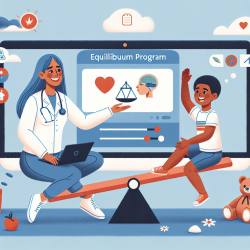Introduction
As speech-language pathologists (SLPs) working in schools, we are often faced with the challenge of meeting the diverse needs of our students while navigating logistical and resource constraints. With the advent of online therapy services, such as those provided by TinyEYE, there is a growing body of research supporting their efficacy in delivering speech therapy in schools. This blog aims to explore the data-driven evidence that supports the use of online therapy services and how they can create positive outcomes for children.
The Rise of Online Therapy Services
Online therapy services have emerged as a viable solution to address the shortage of SLPs in schools and to reach students in remote or underserved areas. These services leverage technology to provide high-quality, individualized therapy sessions that are both convenient and effective. According to a study published in the Journal of Telemedicine and Telecare, online speech therapy has been shown to be as effective as traditional in-person therapy, with comparable outcomes in improving communication skills.
Data-Driven Benefits of Online Speech Therapy
Data supports several key benefits of online speech therapy in schools:
- Accessibility: Online therapy services can reach students in rural or remote areas who may not have access to in-person therapy services. This ensures that all students have the opportunity to receive the support they need.
- Flexibility: Online therapy sessions can be scheduled at convenient times for students, teachers, and families, reducing the disruption to the school day.
- Consistency: Regular sessions can be maintained more easily, which is crucial for the progress of students receiving speech therapy.
- Cost-Effectiveness: By reducing travel and administrative costs, online therapy can be a more cost-effective solution for schools.
Evidence-Based Outcomes
Research indicates that students receiving online speech therapy show significant improvements in their communication skills. A study conducted by the American Speech-Language-Hearing Association (ASHA) found that students who participated in online therapy demonstrated progress in articulation, language, and social communication skills, comparable to those receiving in-person therapy.
Creating a Supportive Environment
For online therapy to be effective, it is essential to create a supportive environment. This includes ensuring that students have access to necessary technology, providing a quiet space for sessions, and involving parents and teachers in the therapy process. By fostering a collaborative approach, SLPs can enhance the effectiveness of online therapy and support the child's overall development.
Conclusion
Online therapy services, such as those offered by TinyEYE, provide a data-driven approach to delivering speech therapy in schools. By utilizing technology, SLPs can reach more students, offer flexible and consistent therapy sessions, and ultimately improve communication outcomes for children. As the evidence continues to grow, it is clear that online speech therapy is not just a temporary solution but a powerful tool in our therapeutic arsenal.










